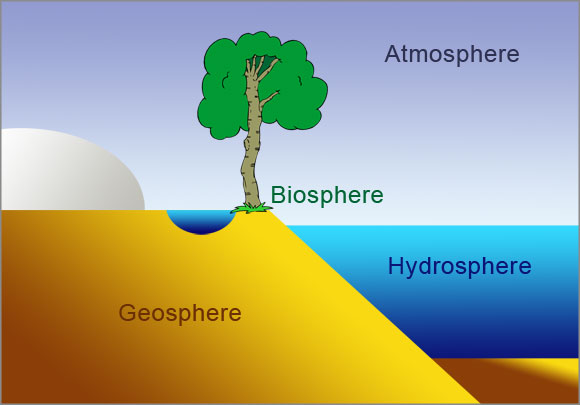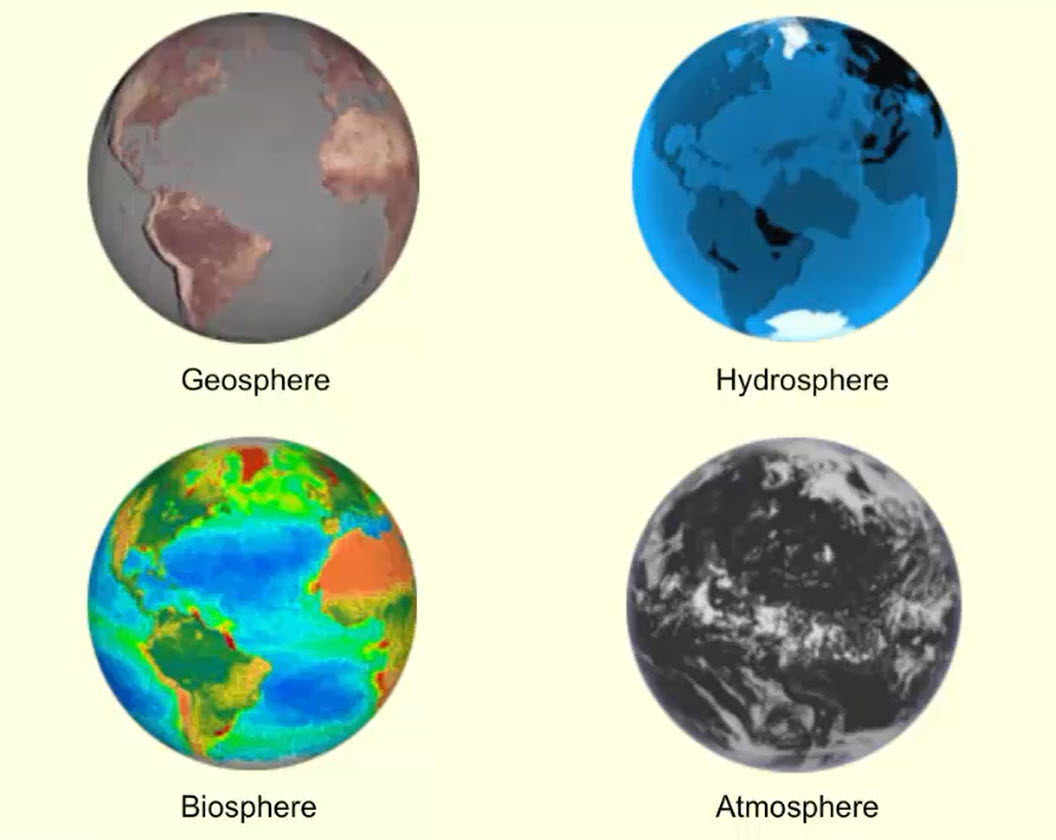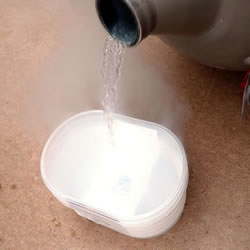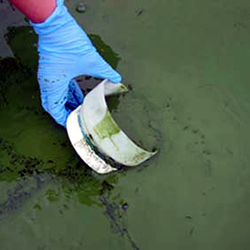Earth's Support Systems
 Earth support systems interact with one another. They are necessary for life on earth.
Earth support systems interact with one another. They are necessary for life on earth.
Planet earth is made up of four major support systems. Can you guess what they are by clicking on the animation below?
Each of the systems performs important and unique functions to support life on Earth, but all four systems interact with one another. Click the image below.
Text Version
The Geosphere
Earth's geosphere is a dynamic and powerful system that makes it possible for life to exist on earth and yet also poses danger to many regions of the planet. Using this worksheet take a journey into the dynamic earth to learn more about how the geosphere works.
https://www.learner.org/wp-content/interactive/dynamicearth/structure/index.html
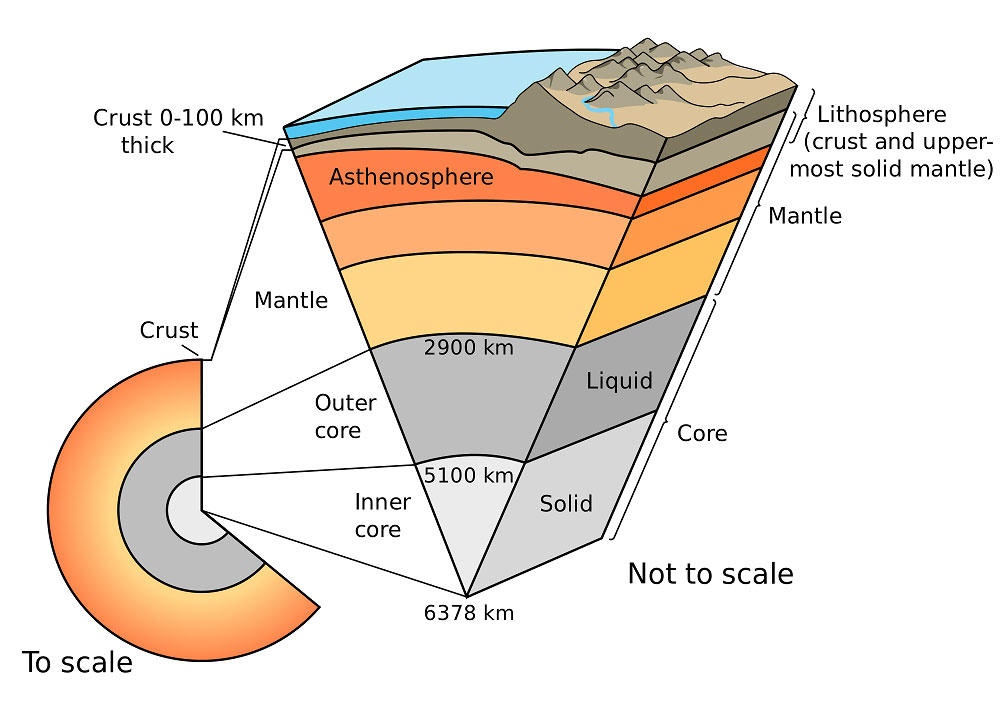
A cross-section of the Earth, showing the sub-surface layers that are being mapped. USGS, Public Domain.
Answer:

Volcanoes, earthquakes, landslides, and floods are all examples of violent events in the geosphere that pose a danger to life. However, the same processes that create these violent events also create mineral and oil resources, metals, raw building materials, soil, and other materials that support living systems.
The Hydrosphere
Answer
According to the US Geological Survey, there is approximately 333 million cubic miles (mi3) of water on earth. To put this in perspective, a cubic mile of water is approximately 1.1 trillion gallons and a cubic kilometer equals about 264 billion gallons. Now that is a lot of water!
The earth is unique in our solar system because of the enormous amount of liquid water on the surface. How does that water help support life on earth? The earth has a fixed amount of liquid water that is collected, purified, and distributed around the planet by the water cycle, also called the hydrologic cycle. This recycling of water in the hydrosphere is crucial to supporting life on earth. You'll learn more about the hydrologic cycle later.
Click each image below.
- Fresh Water for Life
We need water to survive. Water makes up more than 50% of our body weight, and we know that nearly all forms of life on earth depend upon a supply of fresh water to survive.
- Oceans & Climate
The oceans regulate the climate and affect much of the weather on earth. They transport heat around the planet and make it possible for life to survive in environments that would otherwise not sustain life.
- Water & Weathering
Water contributes to weathering and erosion, where water breaks down rocks to release minerals into the soil or water. These minerals support plant growth and are necessary for the health of all animals.
The Atmosphere
The atmosphere is a layer of gases that extends from the surface of the earth to an altitude of approximately 400 miles. However, almost 99 percent of the atmosphere lies within 18 miles of the surface. Take a look at the images below. They are liquid forms of the two main gases that make up the atmosphere. Can you guess what they are?
Click each image below.
- Liquid Nitrogen
Over 78% of the earth’s atmosphere is made up of nitrogen.
- Oxygen
Over 78% of the earth’s atmosphere is made up of nitrogen. The remainder of the atmosphere is made of oxygen.
Answer
The atmosphere contains oxygen, which supports animal life, and carbon dioxide, which plants use to produce their own energy. Additionally, the atmosphere protects us from harmful radiation and regulates the temperature on earth.
Challenge!
Let's see how much you know about the living things on earth.
This is true! It is believed that we have only begun to discover all of the living organisms on earth. Most of the organisms yet to be discovered include small insects, bacteria and other microbes.
This again is true! The range is so large because it is unknown just how many organisms are yet to be discovered.
Plants take in carbon dioxide from the atmosphere, while animals release carbon dioxide to the atmosphere. Conversely, animals take in oxygen while plants provide oxygen gas. Living systems help to purify and circulate water. The geosphere depends on biological processes to break down some rocks and to help form others.
The Biosphere
The biosphere is composed of a huge variety of living things: plants, insects, mammals, fish, birds, bacteria, fungi…Life has made a home in nearly every corner of the planet from the driest, hottest deserts of Africa to the frigid ice fields of the Antarctic. Even in highly acidic hot springs you will find living things. Life is everywhere!. We tend to think of all the ways in which other systems support life, but the biosphere also enables Earth's geosphere, hydrosphere, and atmosphere to function.
